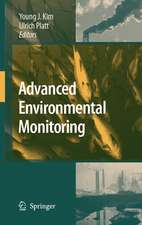Sensor Systems for Environmental Monitoring: Volume Two: Environmental Monitoring
Autor M. Campbellen Limba Engleză Hardback – 31 dec 1996
| Toate formatele și edițiile | Preț | Express |
|---|---|---|
| Paperback (2) | 1218.53 lei 6-8 săpt. | |
| SPRINGER NETHERLANDS – 20 sep 2011 | 1218.53 lei 6-8 săpt. | |
| SPRINGER NETHERLANDS – 3 oct 2011 | 1220.75 lei 6-8 săpt. | |
| Hardback (2) | 1224.54 lei 6-8 săpt. | |
| SPRINGER NETHERLANDS – 31 dec 1996 | 1224.54 lei 6-8 săpt. | |
| SPRINGER NETHERLANDS – 31 dec 1996 | 1226.90 lei 6-8 săpt. |
Preț: 1226.90 lei
Preț vechi: 1496.22 lei
-18% Nou
Puncte Express: 1840
Preț estimativ în valută:
234.87€ • 241.69$ • 197.99£
234.87€ • 241.69$ • 197.99£
Carte tipărită la comandă
Livrare economică 01-15 martie
Preluare comenzi: 021 569.72.76
Specificații
ISBN-13: 9780751404197
ISBN-10: 0751404195
Pagini: 359
Ilustrații: XVII, 359 p.
Dimensiuni: 155 x 235 x 22 mm
Greutate: 0.71 kg
Ediția:1997
Editura: SPRINGER NETHERLANDS
Colecția Springer
Locul publicării:Dordrecht, Netherlands
ISBN-10: 0751404195
Pagini: 359
Ilustrații: XVII, 359 p.
Dimensiuni: 155 x 235 x 22 mm
Greutate: 0.71 kg
Ediția:1997
Editura: SPRINGER NETHERLANDS
Colecția Springer
Locul publicării:Dordrecht, Netherlands
Public țintă
ResearchCuprins
Volume.- 1 Land pollution.- 1.1 Introduction.- 1.2 Common contaminant types and environmental behavior.- 1.3 Sampling and analytical procedures.- 1.4 Monitoring equipment and instrumentation.- 1.5 Summary.- References.- 2 Water pollution.- 2.1 Introduction.- 2.2 Sampling.- 2.3 Continuous monitoring.- 2.4 Physical variables.- 2.5 Chemical variables.- 2.6 Biological variables.- 2.7 Conclusions -.- Acknowledgements.- References.- 3 Air pollution.- 3.1 Introduction.- 3.2 Characterisation of atmospheric pollutants.- 3.3 Air pollution sampling.- 3.4 Monitoring modes.- 3.5 Conclusions.- References.- 4 Periodic methods for monitoring air pollution.- 4.1 Introduction.- 4.2 Sampling: the problems to overcome.- 4.3 Losses to the sample line.- 4.4 Classification of pollutants.- 4.5 Classification of air samplers.- 4.6 Detection limit.- 4.7 Gas velocity and total flow in a duct.- 4.8 Measurement of particulate in ducts.- 4.9 Sampling devices for non-reactive gases and vapours.- 4.10 Wet impingers and sintered glass absorbers.- 4.11 Cryogenic methods.- 4.12 Odour measurement.- 4.13 Instrumental methods for use in the field.- 4.14 Standard atmospheres.- 4.15 Selected methods.- 4.16 Conclusion.- Acknowledgements.- Appendix 1: References to the Environmental Protection Agency of the USA.- Appendix 2: References to the NIOSH methods.- Appendix 3: References to the Health and Safety Executive methods for the determination of hazardous substances (HSE MDHS).- Appendix 4: References to the ASTM standard methods.- References.- 5 Industrial methods of spectrophotometry measurements in process control.- 5.1 Introduction to process analytical chemistry.- 5.2 Project route.- 5.3 Industrial uses of spectroscopy.- 5.4 Industrial measurements in the UV-visible region.- 5.5 Industrial measurements in the IR region.- 5.6 Quantitative measurement in spectroscopy.- 5.7 Future trends.- References.- 6 Noise and vibration.- 6.1 Introduction.- 6.2 Noise sources.- 6.3 Legislation.- 6.4 Measurement.- 6.5 Noise reduction and control.- 6.6 Future trends.- 6.7 Glossary.- References.- 7 Ionising radiation.- 7.1 Introduction to radiation.- 7.2 Properties of ionising radiation.- 7.3 Sources of ionising radiation.- 7.4 In situ measurements.- 7.5 Sampling.- 7.6 Analytical procedures.- 7.7 Case study.- 7.8 Conclusions.- References.

























